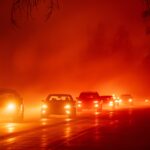Advanced technological tools are making it an exciting time to be an InsurTech – and an exciting time for those insurers and reinsurers that want to more accurately assess the risks on their books, according to Forbes McKenzie, CEO of London-based McKenzie Intelligence Services (MIS).
MIS employs satellite imagery, artificial intelligence and drones to decrease times for claims analysis after natural catastrophes.
“We are looking to decrease times for claims response by 40%, and we’re looking to create exposure management assessments based on fact, which are 90% better than the traditional cat modelling,” said McKenzie in an interview with Carrier Management. (The full interview is available here via an audio podcast).
From his roots in the British army military intelligence, McKenzie began using his expertise for the insurance industry in 2011, at the urging of a contact at Lloyd’s of London who wanted satellite analysis done on the state of energy platforms in Libya. That analysis has now expanded to all natural catastrophes (including pandemics). To learn more about McKenzie’s journey into the insurance industry, you can view this video.
During the interview, McKenzie dove into his company’s work to warn of future pandemics and disease outbreaks. When “something unusual is taking place against the usual background noise,” McKenzie explained that such warnings and indicators can help identify disease outbreaks in the future, “wherever they might occur around the world.”
It’s important to understand “clients’ pain points in advance, particularly around pandemics, and then really, if it’s for insurance and reinsurance, we want to understand what the contract says and understand what triggers various aspects of the insurance contract,” he says. “We can then set artificial intelligence to monitor those particular clauses and warning indicators against those clauses being enacted.”
In the following video segment, he discusses how MIS can use satellite imagery and artificial intelligence to advise clients about future pandemics by looking at “warnings and indicators.”
MIS also uses technology to quickly analyze exposures after natural catastrophes by collecting hard data from the natural catastrophe as it unfolds, whether it is from fire, earthquake, flood or wind. Satellite imagery, airplanes, drones and even the CCTV in an Amazon Ring can help identify damage after a natural catastrophe, says McKenzie, describing how a drone can actually enter a house to examine flood damage. For a deeper dive into this technology, please view the following video.
As for the future, McKenzie looks to some of the technological advances ahead, which will benefit the insurance and reinsurance industry. For example, “deep neural networks” will provide a major advance in smart processing, using artificial intelligence, he says.
MIS also is looking to develop ways to automate non-damage business interruption claims via parametric triggers, said McKenzie, who revealed that MIS also is examining a move into underwriting by entering the managing general agency space, similar to other many other InsurTech companies. For more on MIS’ future plans and the tech revolution ahead, please view the following video:





















 AmFam Reports Underwriting Profit for 2024
AmFam Reports Underwriting Profit for 2024  An Insurance Journalist’s Perspective on Southern California’s Wildfires
An Insurance Journalist’s Perspective on Southern California’s Wildfires  Despite Higher Insurance Costs, Risks, EVs Are Set to Dominate Roads in 2025
Despite Higher Insurance Costs, Risks, EVs Are Set to Dominate Roads in 2025  Winter Weather Loss Prevention: A Strong ROI Opportunity for Property Insurers
Winter Weather Loss Prevention: A Strong ROI Opportunity for Property Insurers 







